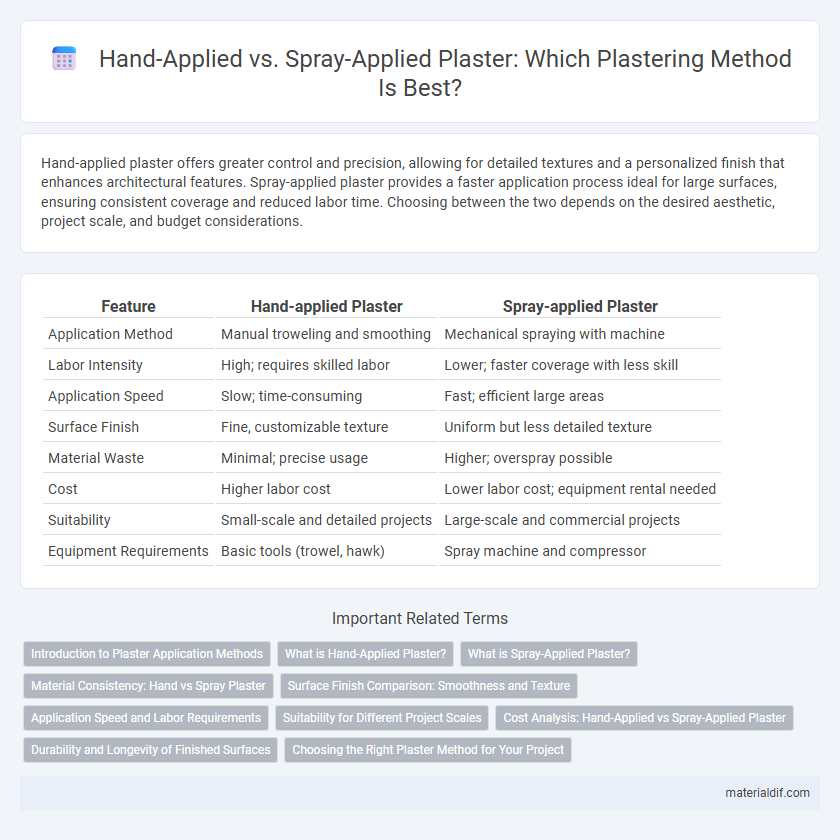Hand-applied plaster offers greater control and precision, allowing for detailed textures and a personalized finish that enhances architectural features. Spray-applied plaster provides a faster application process ideal for large surfaces, ensuring consistent coverage and reduced labor time. Choosing between the two depends on the desired aesthetic, project scale, and budget considerations.
Table of Comparison
| Feature | Hand-applied Plaster | Spray-applied Plaster |
|---|---|---|
| Application Method | Manual troweling and smoothing | Mechanical spraying with machine |
| Labor Intensity | High; requires skilled labor | Lower; faster coverage with less skill |
| Application Speed | Slow; time-consuming | Fast; efficient large areas |
| Surface Finish | Fine, customizable texture | Uniform but less detailed texture |
| Material Waste | Minimal; precise usage | Higher; overspray possible |
| Cost | Higher labor cost | Lower labor cost; equipment rental needed |
| Suitability | Small-scale and detailed projects | Large-scale and commercial projects |
| Equipment Requirements | Basic tools (trowel, hawk) | Spray machine and compressor |
Introduction to Plaster Application Methods
Hand-applied plaster offers precise control and is ideal for detailed finishes on smaller surfaces, using traditional tools like trowels and hawks. Spray-applied plaster enhances efficiency and consistency in large-scale projects, employing pneumatic or electric spray equipment to rapidly cover extensive areas. Selecting between these methods depends on project scale, surface complexity, and desired finish quality.
What is Hand-Applied Plaster?
Hand-applied plaster is a traditional method where skilled craftsmen manually spread and smooth the plaster onto walls or ceilings using trowels and hawks, allowing for precise control over texture and thickness. This technique is ideal for intricate surface detail and uneven substrates, ensuring high-quality finishes in restoration and custom work. Compared to spray-applied plaster, hand application offers superior adaptability to complex architectural features and enhances the durability of the final coat.
What is Spray-Applied Plaster?
Spray-applied plaster is a technique where plaster material is mechanically sprayed onto surfaces using specialized equipment, ensuring uniform coverage and faster application compared to hand-applied methods. This method enhances consistency in texture and thickness, reducing labor time and minimizing material waste. Commonly used in commercial and large-scale residential projects, spray-applied plaster improves efficiency without compromising the durability or finish quality of the plastered surface.
Material Consistency: Hand vs Spray Plaster
Hand-applied plaster allows for precise control over material consistency, enabling craftsmen to adjust thickness and texture based on surface requirements, resulting in a tailored finish. In contrast, spray-applied plaster relies on mechanical mixing and spraying equipment, which ensures uniform material consistency, increasing application speed but potentially limiting customization. The choice between hand and spray application affects the plaster's adhesion, durability, and final aesthetic, with hand application generally preferred for intricate detailing and spray application favored for large surface coverage.
Surface Finish Comparison: Smoothness and Texture
Hand-applied plaster offers superior control over surface finish, enabling artisans to achieve a smooth, finely textured surface tailored to specific design preferences. In contrast, spray-applied plaster provides a more uniform texture but may result in less smoothness due to rapid drying and reduced manual manipulation. Surface smoothness in hand application typically ranges between 1 to 2 microns in roughness, whereas spray application textures often measure around 5 to 10 microns, impacting the final aesthetic and tactile quality.
Application Speed and Labor Requirements
Hand-applied plaster requires skilled labor and significantly more time due to the manual process of spreading and smoothing, often taking several hours per wall depending on surface complexity. Spray-applied plaster dramatically increases application speed by using pneumatic tools to cover large areas quickly, reducing labor hours and enabling faster project completion. Labor requirements for hand application demand higher expertise and physical effort, whereas spray application allows for less specialized workers to achieve consistent results efficiently.
Suitability for Different Project Scales
Hand-applied plaster offers precise control and is ideal for small to medium-sized projects or detailed decorative work, ensuring a smooth, customized finish. Spray-applied plaster is more efficient for large-scale applications, significantly reducing labor time and providing consistent coverage on extensive surfaces. Choosing between these methods depends on project size, desired finish quality, and budget constraints.
Cost Analysis: Hand-Applied vs Spray-Applied Plaster
Hand-applied plaster typically incurs higher labor costs due to the skilled craftsmanship and extended application time required, with average expenses ranging from $3 to $7 per square foot. Spray-applied plaster, benefiting from mechanized application, reduces labor intensity and time, often costing between $2 and $5 per square foot, making it more cost-efficient for large-scale projects. Material costs remain relatively similar, but the lower labor expenditure makes spray-applied plaster the preferred choice for budget-conscious construction and renovation projects.
Durability and Longevity of Finished Surfaces
Hand-applied plaster offers superior durability and longevity due to its precise layering and thorough adhesion, reducing the likelihood of cracking and moisture infiltration over time. Spray-applied plaster, while faster to apply, may result in less consistent thickness and bonding, potentially compromising long-term surface integrity. Proper curing and skilled application are critical factors influencing the lifespan of both hand-applied and spray-applied plaster finishes.
Choosing the Right Plaster Method for Your Project
Hand-applied plaster offers superior control and precision, making it ideal for intricate surfaces and smaller projects where detail and finish quality are paramount. Spray-applied plaster accelerates application time and ensures consistent thickness, suitable for large-scale jobs requiring efficiency and uniform coverage. Selecting between these methods depends on project size, desired finish, and labor resources, balancing cost-effectiveness with aesthetic requirements for optimal results.
Hand-applied Plaster vs Spray-applied Plaster Infographic

 materialdif.com
materialdif.com